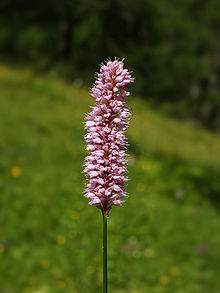- Persicaria bistorta
-
Persicaria bistorta 
Scientific classification Kingdom: Plantae (unranked): Angiosperms (unranked): Eudicots (unranked): Core eudicots Order: Caryophyllales Family: Polygonaceae Genus: Persicaria Species: P. bistorta Binomial name Persicaria bistorta
(L.) Samp.Persicaria bistorta (Bistort or Common Bistort) is a herbaceous flowering plant found throughout Europe. The generic placement of this species is in flux. While treated here as in Persicaria, it has also been placed in Polygonum or Bistorta.
The Latin name "bistorta" refers to the twisted appearance of the root. In Northern England the plant was used to make a bitter pudding in Lent from a combination of the plant's leaves, oatmeal, egg and other herbs. It is the principal ingredient of dock pudding or Easter-Ledge Pudding. [1] The root of Bistort can be used to produce an astringent that was used in medicine.
Numerous other vernacular names have been recorded for the species in historical texts, though none is used to any extent. Many of the following refer to the plant's use in making puddings: Adderwort, Dragonwort, Easter giant, Easter ledger, Easter ledges, Easter magiant, Easter man-giant, Gentle dock, Great bistort, Osterick, Oysterloit, Passion dock, Patience dock (this name is also used for Rumex patientia), Patient dock, Pink pokers, Pudding grass, Pudding dock, Red legs, Snakeweed, Twice-writhen, Water ledges.
Description
Plants bloom late spring into mid summer, producing tall stems ending in single terminal racemes that are club-like spikes of pink-rose colored flowers. The racemes are about 2 cm thick and 5-9 cm long and end 1 meter tall,upright growing stems. Plants grow in moist soils and under dry conditions go dormant, losing their foliage until adequate moisture exists again. This species is grown as an ornamental garden plant, especially the form 'Superba' which has larger, more showy flowers. Typically alpine plants growing from short, thick rhizomes that branch. The foliage is normally basal with a few smaller leaves produced near the lower end of the flowering stems. The leaves are oblong-ovate or triangular-ovate in shape and narrow at the base. The petioles are broadly winged.
Gallery
-
The large-flowered cultivar Persicaria bistorta 'Superba' is grown as an ornamental plant.
-
In Vitosha, Bulgaria
References

This Polygonaceae article is a stub. You can help Wikipedia by expanding it.





